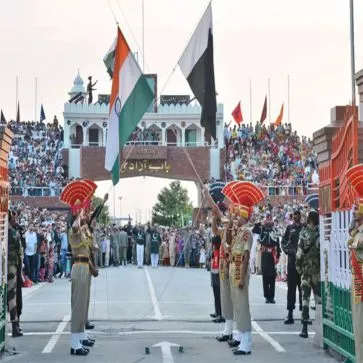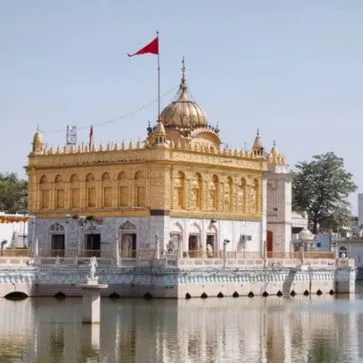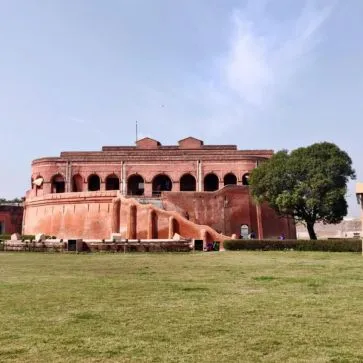Amritsar, a historic city in Punjab, India, is known for its rich culture, heritage, and spirituality. While the Golden Temple remains its main tourist site, the surrounding region offers a variety of unique destinations that highlight its history, nature, and local traditions. Exploring these nearby places adds depth to the visit, offering a more comprehensive experience of Amritsar and its vibrant surroundings.
Overview of Amritsar and its Surroundings
Amritsar is situated in the northwestern part of India, close to the Pakistan border. The city is renowned for its religious significance, particularly to Sikhs, and boasts a blend of historic monuments, cultural sites, and natural beauty. Beyond the city, the surrounding areas offer diverse experiences, from historical landmarks and serene temples to picturesque landscapes and wildlife sanctuaries.
Importance of Exploring Nearby Destinations
Exploring the nearby destinations around Amritsar enhances the travel experience by better understanding the region’s heritage and natural beauty. These sites complement the spiritual journey and showcase the diverse culture, history, and landscapes that make Amritsar and its surroundings unique. Whether you’re interested in history, culture, or nature, these nearby places are essential to fully appreciating the richness of this region.
Golden Temple & Guided Tour
Historical Significance
The Golden Temple, also known as Harmandir Sahib, is the holiest shrine in Sikhism. Founded in the 16th century by Guru Arjan Dev, it symbolizes the ideals of equality, humility, and devotion. The temple’s architecture blends Hindu and Islamic styles and has been a central figure in Sikh history, attracting pilgrims worldwide.
Visitor Experience
Visitors to the Golden Temple experience a sense of peace and spirituality. The temple is surrounded by a serene lake, offering a tranquil atmosphere. Pilgrims and tourists alike can participate in prayers, walk around the sacred pool, and admire the intricate golden facade. The community kitchen (Langar) serves free meals to thousands daily, showcasing the Sikh principle of selfless service.
Jallianwala Bagh
Historical Importance
Jallianwala Bagh is a historic tourist destination in Amritsar, known for the tragic massacre on April 13, 1919, when British troops opened fire on a peaceful gathering of Indians protesting colonial rule. This event marked a turning point in India’s struggle for independence, igniting widespread outrage and becoming a symbol of resistance against British oppression.
Key Attractions
The memorial at Jallianwala Bagh includes a Martyrs’ Gallery, a flame that burns continuously in remembrance, and the well into which many people jumped to escape the bullets. The preserved bullet marks on the walls and the memorial garden offer visitors a poignant insight into the sacrifice and bravery of those who lost their lives during the massacre.
Wagah Border
Flag Ceremony and Border Views
The Wagah Border between India and Pakistan is famous for its daily flag-lowering ceremony. This highly energetic and patriotic event involves soldiers from both countries performing synchronized drills as they lower their respective flags, accompanied by a lively crowd. Visitors can witness the dramatic display of military precision and national pride from both sides of the border.
Cultural Significance
The Wagah Border holds deep cultural and symbolic significance as it represents the division between India and Pakistan since their Partition in 1947. The ceremony highlights the spirit of rivalry and unity, fostering a sense of national pride while promoting peace and camaraderie between the two nations. It has become a symbol of the resilience and shared history of the region.
Durgiana Temple
Architecture and Religious Importance
Durgiana Temple, dedicated to Goddess Durga, is an important Hindu pilgrimage tourist site in Amritsar. The temple’s architecture closely resembles the Golden Temple, featuring a central sanctum surrounded by a holy tank. It holds great religious significance, especially for devotees of Goddess Durga, and attracts visitors seeking blessings and spiritual solace.
Local Culture
The temple is integral to Amritsar’s cultural landscape, blending religious practices with local traditions. It serves as a hub for religious festivals and events, fostering a strong sense of community. The surrounding area is filled with vibrant markets and cultural experiences, reflecting the region’s rich heritage.
Gobindgarh Fort
Historical Overview
Gobindgarh Fort, built in the 18th century, has a rich history linked to the Maharaja of Patiala and later the British colonial era. It served as a military stronghold and was key during various historical conflicts. The fort has recently been renovated and opened to the public, preserving its historical significance.
Attractions and Entertainment
Today, Gobindgarh Fort offers a variety of attractions, including cultural performances, sound-and-light shows, and museums showcasing the region’s history. Visitors can explore its ancient walls, galleries, and interactive exhibits, making it a blend of history and entertainment. The fort also features shops, dining options, and traditional Punjabi experiences, adding to its appeal.
Partition Museum
Legacy of the Partition
The Partition Museum in Amritsar preserves the memories and stories of the 1947 Partition of India and Pakistan, a traumatic event that led to widespread displacement, violence, and loss. It highlights the human cost of the division, showcasing the emotional and historical impact on millions of people.
Key Exhibits
The museum features many exhibits, including personal stories, photographs, letters, and artifacts from those who experienced the Partition. Interactive displays and multimedia presentations offer visitors a powerful insight into the challenges faced during this pivotal historical moment.
Pul Kanjari
Historical Context
Pul Kanjari is a historic village and tourist site near Amritsar, known for its association with Maharaja Ranjit Singh. The town is named after a legend involving a woman named Kanjari, and it became a key location during the reign of Ranjit Singh, who built a bridge here to facilitate travel across the area.
Attractions and Nearby Sites
Pul Kanjari features historical structures, including a mosque, a gurdwara, and remnants of the bridge built by Maharaja Ranjit Singh. Visitors can explore these landmarks while also enjoying the scenic surroundings. Nearby, attractions like the Harike Wetland and Bird Sanctuary offer natural beauty and wildlife experiences.
Khalsa College
Architectural Grandeur
Khalsa College in Amritsar is renowned for its stunning architectural design, blending traditional Sikh and Mughal styles. The grand structure features large domes, intricate carvings, and expansive lawns, making it a prominent landmark in the city.
Educational Importance
Founded in 1892, Khalsa College is a prestigious institution that has played a significant role in the educational development of the region. It offers various academic programs and has contributed to students’ intellectual and cultural growth, fostering values of service, equality, and academic excellence.
Akal Takht
Spiritual Significance
Akal Takht is one of the five holy Takhts (thrones) in Sikhism and serves as the supreme religious and temporal authority for Sikhs. Located in Amritsar, it symbolizes the spiritual strength and unity of the Sikh community, upholding Sikh values and guiding religious practices.
Historical Background
Founded by Guru Hargobind in 1609, Akal Takht was established as a center of political and religious governance. It played a crucial role in Sikh history, especially during conflict, representing their commitment to justice and righteousness while balancing spiritual and temporal matters.
Ram Tirath
Mythological Significance
Ram Tirath is an essential religious tourist site in Amritsar, associated with the mythological tales of Lord Rama. It is believed to be where Mata Sita gave birth to her twin sons, Lava and Kusha, making it a significant pilgrimage destination for Hindus.
Temple and Surroundings
The temple at Ram Tirath is dedicated to Lord Rama and Mata Sita, and the surrounding area is peaceful, with a sacred pond and lush greenery. The site attracts devotees who come to offer prayers and reflect on its rich mythological and spiritual history.
Sadda Pind
Cultural Village Experience
Sadda Pind is an immersive cultural village and tourist attraction near Amritsar that offers visitors a glimpse into traditional Punjabi life. It showcases the region’s customs, arts, and crafts, providing an authentic experience of rural Punjab.
Traditional Punjabi Lifestyle
The village is designed to reflect the traditional Punjabi lifestyle, with displays of folk dances, music, local cuisine, and handicrafts. Visitors can experience the warmth of Punjabi hospitality, learn about local traditions, and enjoy interactive activities that highlight the culture and heritage of the region.
Kesar Bagh

Kesar Bagh is typically a beautifully designed garden or a retreat center known for its scenic beauty and peaceful atmosphere. The name “Kesar” often refers to saffron, which could indicate the presence of saffron-colored flowers or the historical significance of saffron in the area. Depending on its context, it may also be the name of a specific location or a renowned garden. Visitors often come to Kesar Bagh to experience natural beauty and tranquility.
A Peaceful Retreat
A peaceful retreat refers to a place or destination designed for rest, relaxation, and escape from the stresses of daily life. It often involves a calm, serene environment, far from the noise and distractions of busy cities. A peaceful retreat offers an opportunity to rejuvenate both physically and mentally, surrounded by nature, quiet surroundings, and some therapeutic activities or wellness programs.
Gardens and Leisure Activities
Gardens in the context of Kesar Bagh serve as peaceful sanctuaries where visitors can enjoy the beauty of plants, flowers, and natural landscapes. These gardens often have walking paths, meditation areas, and spaces to enjoy the outdoors. Leisure activities in such settings could include things like nature walks, bird watching, picnics, or even cultural events, all of which help to enhance the relaxation experience. These activities encourage visitors to slow down, appreciate nature, and enjoy light, enjoyable pastimes.
Together, these elements describe a place where people can unwind, connect with nature, and participate in calming leisurely pursuits.
Harike Wetland and Bird Sanctuary

Harike Wetland and Bird Sanctuary, located in Punjab, India, is an essential ecological site formed by the confluence of the Beas and Sutlej Rivers. It hosts over 375 bird species, particularly migratory ones, and supports diverse wildlife, including aquatic life and plants. The sanctuary is a protected area key to conservation and flood prevention.
Wildlife and Nature Exploration
Wildlife and nature exploration involves discovering and observing animals, plants, and natural landscapes in their native environments. This includes activities like safaris, trekking, birdwatching, and camping. It promotes environmental awareness, conservation, and an appreciation of ecosystems, often through ecotourism and educational efforts.
Bird Watching Opportunities
Bird watching involves observing birds’ natural habitats, such as wetlands, national parks, and forests. It is a popular activity for nature enthusiasts and researchers, with opportunities to see a variety of bird species. Bird watching enhances understanding of wildlife, contributes to conservation efforts, and offers relaxation and education.
Mata Lal Devi Mandir

Mata Lal Devi Mandir in Amritsar is a prominent Hindu temple dedicated to Mata Lal Devi, a revered local goddess. It holds profound religious and cultural significance and is visited by many devotees. Below is an explanation of its pilgrimage and spiritual importance, as well as its architecture and history:
Pilgrimage and Spiritual Significance
- Spiritual Importance: Mata Lal Devi Mandir is dedicated to Mata Lal Devi, who is believed to be an incarnation of the Divine Mother, known for her ability to fulfill the wishes of her devotees. She is especially worshipped for blessings related to family welfare, health, and prosperity. Devotees believe that the goddess has miraculous powers, and they visit the temple to seek her blessings, particularly for fertility, health, and protection.
- Pilgrimage Site: The temple is a significant pilgrimage site for Hindus, particularly women, who come to pray for children and safety during childbirth. People from various parts of India visit the temple to seek spiritual solace and offer offerings to the goddess. It holds particular importance during festivals like Navratri, which celebrates the worship of Goddess Durga and other forms of the Divine Mother.
- Faith and Miracles: Many devotees visit the temple believing the goddess can intervene in their lives miraculously. This strong faith in the goddess adds to the spiritual aura of the temple, making it a key site for religious pilgrimages.
Architecture and History
Architecture: Mata Lal Devi Mandir has a unique architectural design that stands out among other regional temples. The temple is built within a cave-like structure, with narrow passages leading to the main shrine. This creates a mystical and immersive experience for visitors, as they feel they are walking through the goddess’s sacred space. The temple is adorned with intricate carvings, idols, and decorations that depict Hindu religious symbols and divine figures. The main shrine houses an idol of Mata Lal Devi, which is central to the worship.
History: The history of Mata Lal Devi Mandir is intertwined with the story of Mata Lal Devi herself, a woman who was known for her devotion and spiritual powers. The temple is believed to have been established to honor her and her connection with the divine. Over the years, it has grown in popularity and become one of the most visited temples in Amritsar, a city known for its deep spiritual significance. The temple’s roots can be traced to local folklore, with stories of the goddess’s miracles and blessings spreading throughout the region.
In conclusion, Mata Lal Devi Mandir in Amritsar is a key pilgrimage and spiritual site for Hindus. The temple’s unique architecture, with its cave-like passageways and devotional idols, enhances the mystical experience for visitors. Its rich history and belief in the goddess’s miraculous powers make it a highly revered place of worship.
Sufi Shrine of Hazrat Syed Bahauddin

The Sufi Shrine of Hazrat Syed Bahauddin is a revered spiritual site in India dedicated to the Sufi saint Hazrat Syed Bahauddin. He was a prominent Sufism figure known for his piety, spiritual wisdom, and contributions to Islamic teachings. The shrine attracts many devotees and visitors, especially during the annual urs (death anniversary) celebrations, when people gather for prayers rituals, and to seek blessings. The shrine is known for its peaceful atmosphere and is an essential center for spiritual reflection and Sufi traditions.
Historical and Spiritual Role
The Sufi Shrine of Hazrat Syed Bahauddin in India is essential for Sufi Muslims. It honors Hazrat Syed Bahauddin, a revered Sufi saint known for his spiritual teachings and contributions to Islam. The shrine serves as a place of pilgrimage where devotees seek blessings, guidance, and spiritual healing.
Unique Attractions
The shrine is known for its peaceful ambiance, offering visitors a chance for reflection and prayer. Its unique attractions include intricate architecture, sacred rituals, and a spiritual atmosphere that attracts religious followers and tourists interssted in Sufi culture. The site is also famous for the annual urs (death anniversary) celebrations, which draw large crowds.
Rambagh Gardens

Rambagh Gardens in Amritsar is a historic and scenic public garden known for its lush greenery, beautiful landscaping, and peaceful ambiance. Originally built as a royal garden, it is now a popular destination for locals and tourists. The garden features vibrant flowers, fountains, and wide walking paths, making it ideal for relaxation, leisurely walks, and photography. Its serene environment provides a refreshing escape from the city’s bustle, making it a perfect place for family outings and casual visits.
Scenic Beauty
Rambagh Gardens, located in Amritsar, is a beautiful, well-maintained garden that offers a serene escape from the city’s hustle. It is a picturesque spot with lush greenery, vibrant flowers, and carefully designed landscapes. The garden’s scenic beauty, fountains, trees, and calm ambiance make it a popular destination for nature lovers and photography enthusiasts.
Recreational Activities
Rambagh Gardens offers a range of recreational activities, including strolls, picnics, and photography. Visitors can enjoy the peaceful environment while walking along its paths, relaxing by the fountains, or simply soaking in the natural surroundings. It also serves as an excellent place for family outings and casual gatherings.
Jama Masjid Amritsar

The Jama Masjid in Amritsar is a prominent mosque known for its spiritual significance and architectural beauty. It serves as an essential place of worship for Muslims in the region, offering prayers and religious activities. The mosque draws locals and visitors due to its peaceful atmosphere and cultural importance.
Islamic Architecture
The mosque is a fine example of Islamic architecture, featuring traditional elements such as arched doorways, minarets, and a spacious prayer hall. Its design reflects classic Mughal influences, with intricate carvings, detailed arches, and symmetrical structures characteristic of Islamic buildings.
Cultural Heritage
Jama Masjid Amritsar is an integral part of the city’s cultural heritage, representing the region’s rich Islamic history and traditions. It holds religious and historical significance, and its architectural features are a testament to the artistic achievements of the era. The mosque continues to be an essential symbol of Amritsar’s cultural and spiritual diversity.
Sikh Museum

A cultural institution dedicated to preserving and showcasing the history, traditions, and heritage of Sikhism.
History of Sikhism
The Sikh religion, founded in the 15th century by Guru Nanak in the Punjab region of India, emphasizes equality, service, and devotion to God. It has a rich history of spiritual and political significance.
Artifacts and Exhibitions
The museum features a variety of artifacts, including sacred texts, clothing, weapons, and personal items belonging to Sikh Gurus and historical figures, offering insights into the religion’s development and cultural legacy.
Baba Bakala

Baba Bakala is a town in Punjab, India, known for its association with Guru Tegh Bahadur, the ninth Sikh Guru. It is an important pilgrimage site for Sikhs.
Religious Significance
Baba Bakala is significant because Guru Tegh Bahadur spent time here before being declared the Guru. It is believed to be where the Guru’s identity was revealed to his followers. The town is a symbol of spiritual enlightenment and devotion.
Spiritual Sites Nearby
Nearby spiritual sites include gurdwaras (Sikh temples) like Gurdwara Sri Baba Bakala Sahib, where Guru Tegh Bahadur’s followers gathered, as well as other historic gurdwaras in the region connected to Sikh history and the Gurus’ lives.
Virasat-e-Khalsa

Virasat-e-Khalsa is a museum and cultural complex located in Anandpur Sahib, Punjab. It showcases the rich history, heritage, and culture of the Sikh religion, mainly focusing on the Sikh Khalsa tradition.
Sikh Heritage Museum
The Sikh Heritage Museum, part of Virasat-e-Khalsa, features extensive collections that highlight key events in Sikh history, including the lives of the Gurus, the formation of the Khalsa, and the religious and cultural contributions of Sikhs over the centuries.
Cultural Exhibits
The museum hosts a variety of cultural exhibits, including artworks, religious artifacts, manuscripts, and weapons. These exhibits give visitors a deeper understanding of Sikhism’s traditions and rituals and its impact on global history.
Bhagat Singh Memorial

The Bhagat Singh Memorial is a monument dedicated to Bhagat Singh, one of India’s most revered freedom fighters. Located in his hometown of Banga, Punjab, it honors his legacy and contributions to India’s struggle for independence.
Tribute to the Freedom Fighter
The memorial is a tribute to Bhagat Singh’s courage, revolutionary spirit, and ultimate sacrifice for India’s independence. It commemorates his role in fighting British colonial rule and inspiring future generations with his ideals.
Historical Context
Bhagat Singh was a key figure in the Indian independence movement during the early 20th century. He was involved in several revolutionary activities, including the bombing of the Central Legislative Assembly in Delhi, and was martyred by the British in 1931. His execution galvanized the Indian freedom movement and left a lasting impact on the country’s history.
Panj Takht

The Panj Takht refers to the five central Sikh seats of authority, which are significant places of worship and spiritual leadership in Sikhism. These five Takhts are located in different regions of India.
Importance in Sikhism
The Panj Takhts hold immense religious and historical importance in Sikhism. They are considered the supreme decision-making center in Sikh doctrine, practice, and community affairs. The five Takhts are Akal Takht (Amritsar), Takht Sri Patna Sahib, Takht Sri Hazur Sahib, Takht Sri Damdama Sahib, and Takht Sri Keshgarh Sahib.
Spiritual Journey
Visiting the Panj Takhts is essential to a Sikh’s spiritual journey. Each Takht offers unique historical significance and spiritual teachings, allowing pilgrims to deepen their faith, connect with Sikh history, and seek spiritual growth.
Chesworth Lake

Chesworth Lake is a scenic and peaceful location set amidst natural surroundings, making it an ideal destination for nature lovers and outdoor enthusiasts.
Peaceful Escape
The lake offers a serene atmosphere, perfect for those seeking a quiet retreat away from the hustle and bustle of daily life. Visitors can enjoy strolls, birdwatching, or relax by the water.
Boating and Leisure Activities
The lake is a popular spot for recreational boating, allowing visitors to enjoy calm waters. Other leisure activities such as picnicking, fishing, and walking trails further enhance the experience, making it a versatile destination for all types of visitors.
Ready to Embark on Your Amritsar Adventure?
Now that you’ve explored the top 23 must-visit tourist attractions near Amritsar, it’s time to take the next step and make your travel dreams come true! From the spiritual beauty of the Golden Temple to the captivating historical sites, Amritsar offers something for every type of traveler.
To truly experience the city’s magic, why not join one of Walk and Explore’s expertly guided tours? Our Amritsar tours are designed to offer you a more profound, more personal experience of this vibrant city and its surroundings.
Our Amritsar Tours Include:
- Golden Temple and Jallianwala Bagh Tour
- Heritage Walk Through the Old City
- Amritsar Food Tour – Savor the city’s best street food
- Sikh History and Culture Tour
- Sunset at Attari Border and Wagah Ceremony Tour
- Visit to the Durgiana Temple and Ram Bagh Gardens
Start Your Journey with Walk and Explore!
Visit Walk and Explore to book your tour today, and get ready to explore Amritsar like never before. Your adventure awaits!
Summary of Key Attractions
Key attractions in Amritsar include the Golden Temple, Jallianwala Bagh, the Wagah Border ceremony, and the Partition Museum. These sites reflect the city’s spiritual and historical importance, attracting visitors worldwide.
Best Time to Visit Amritsar and its Surroundings
The best time to visit Amritsar is during the cooler months, from October to March. This period offers pleasant weather for sightseeing and comfortably exploring the city’s attractions. Avoid visiting during the extreme heat of summer.













